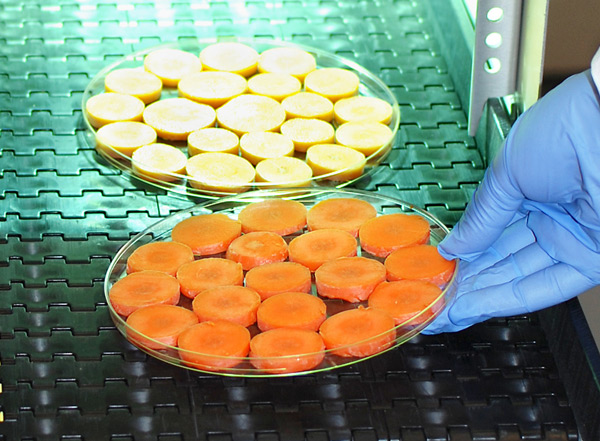

Feb 22, 2011Ultraviolet light can boost antioxidants in carrots
Exposing sliced carrots to UV-B, one of the three kinds of ultraviolet light in sunshine, can boost the antioxidant activity of the colorful vegetable. That’s according to preliminary studies by USDA research food technologist and research leader Tara H. McHugh. She is with the Agricultural Research Service (ARS), USDA’s chief intramural scientific research agency.
Found primarily in fruits and vegetables, antioxidants are natural compounds that may reduce risk of cancer and cardiovascular disease.
The carrot investigation, conducted by McHugh, postdoctoral associate Wen-Xian Du and others at the ARS Western Regional Research Center in Albany, Calif., suggests that a moderate, 14-second dose of UV-B can boost fresh, sliced carrots’ antioxidant capacity about three-fold. The dose is energy-efficient, and does not significantly heat or dry the carrots.
Scientists have known for at least a decade that exposing plants to UV-B may cause what’s known as abiotic stress. That’s what probably happened with the sliced carrots.
Plants respond to the stress by revving up their production of two natural enzymes, one with the tongue-twisting name of polyphenylalanine ammonia-lyase, and the other known as chalcone synthase. As production of those enzymes increases, levels of phenolic compounds – antioxidants synthesized by the enzymes – also increase.
Despite this and other knowledge about plants’ responses to stress and to UV-B, the idea of using UV-B to quickly, safely and conveniently enrich the antioxidant heft of fresh produce has not been extensively studied, McHugh said. The carrot research is helping fill in that knowledge gap.
So will similar, ongoing studies at the Albany lab, funded by ARS and a grant awarded to McHugh and Albany co-investigator Andrew Breksa in 2009 by USDA’s National Institute of Food and Agriculture.
In earlier research, McHugh and colleagues worked with the Mushroom Council, San Jose, Calif., and Monterey Mushrooms Inc., Watsonville, Calif., to explore the potential of using UV-B to boost the vitamin D content of mushrooms. The idea was not new but, at the time, had yet to be commercialized.
Mushrooms are rich in ergosterol, which can be converted by sunlight into vitamin D. But since commercial mushrooms are typically grown in the dark, their vitamin D levels are usually low. McHugh and Monterey Mushrooms worked out a practical procedure for using UV-B at the packinghouse to capitalize on mushrooms’ ergosterol. That resulted in the company’s 2008 launch of its line of vitamin D-rich mushrooms, the first-ever commercial use of UV-B to increase mushrooms’ vitamin D content.
– By Marcia Wood, ARS














